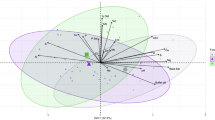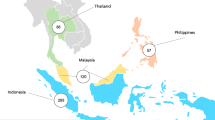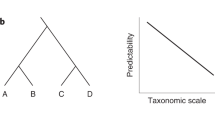Abstract
Many soil bacteria and fungi remain unclassified at the highest taxonomic ranks (e.g. phyla level), which hampers our ability to assess the ecology and functional capabilities of these soil organisms in terrestrial ecosystems globally. The first logical step toward the classification of these unknown soil taxa is to identify potential locations on Earth where these unclassified bacteria and fungi are feasibly most prevalent. To do this, here I used data from a global soil survey across 235 locations, including amplicon sequencing information for fungal and bacterial communities, and generated global atlases highlighting those soils where the percentages of taxa of bacteria and fungi with an unknown phyla are expected to be more prevalent. Results indicate that soil samples with the largest percentage of fungal taxa with an unknown phyla can be found in dry forests and grasslands, while those with the largest percentage of bacterial taxa with an unknown phyla are found in boreal and tropical forests. This information can be used by taxonomists and microbiologists to target these potentially new soil taxa.
Similar content being viewed by others
Log in or create a free account to read this content
Gain free access to this article, as well as selected content from this journal and more on nature.com
or
Data availability
The primary data used in this paper have been deposited in figshare: https://figshare.com/s/f7f34a772b316cdbda24 (https://doi.org/10.6084/m9.figshare.7895675).
References
Bardgett RD, van der Putten WH. Belowground biodiversity and ecosystem functioning. Nature. 2014;515:505–511.
Delgado-Baquerizo M, Maestre FT, Reich PB, Jeffries TC, Gaitan JJ, Encinar D, et al. Microbial diversity drives multifunctionality in terrestrial ecosystems. Nat Commun. 2016;28:10541.
Caporaso JG, Kuczynski J, Stombaugh J, Bittinger K, Bushman FD, Costello EK, et al. QIIME allows analysis of high-throughput community sequencing data. Nat Method. 2010;7:335.
Tedersoo L, Bahram M, Põlme S, Kõljalg U, Yorou NS, Wijesundera R, et al. Fungal biogeography. Global diversity and geography of soil fungi. Science. 2014;346:1256688.
Fierer N. Embracing the unknown: disentangling the complexities of the soil microbiome. Nat Rev Microbiol. 2017;15:579–590.
Marx V. Microbiology: the return of culture. Nat Methods. 2017;14:37–40.
York A. Next-generation bacterial taxonomy. Nat Rev Microbiol. 2018;16:583.
Delgado-Baquerizo M, Oliverio AM, Brewer TE, Benavent-González A, Eldridge DJ, Bardgett RD, et al. A global atlas of the dominant bacteria found in soil. Science. 2018;19:320–325.
DeSantis TZ, Hugenholtz P, Larsen N, Rojas M, Brodie EL, Keller K, et al. Greengenes, a chimera-checked 16S rRNA gene database and workbench compatible with ARB. Appl Environ Microb 2006;72:5069–5072.
Nilsson RH, Larsson K-H, Taylor AFS, Bengtsson-Palme J, Jeppesen TS, Schigel D, Kennedy P, Picard K, Glöckner FO, Tedersoo L, Saar I, Kõljalg U, Abarenkov K. The UNITE database for molecular identification of fungi: handling dark taxa and parallel taxonomic classifications. Nucleic Acids Research 2018;47:259–264.
Zomer RJ, Trabucco A, Bossio DA, Verchot LV. Climate change mitigation: a spatial analysis of global land suitability for clean development mechanism afforestation and reforestation. Agric Ecosyst Envir. 2008;126:67–80.
Delgado-Baquerizo M., Eldridge DJ. Ecosystems. 2019. https://doi.org/10.1007/s10021-018-0333-2.
Herlemann DP, Labrenz M, Jürgens K, Bertilsson S, Waniek JJ, Andersson AF. Transitions in bacterial communities along the 2000 km salinity gradient of the Baltic Sea. ISME J. 2011;5:1571–1579.
Ihrmark K, Bödeker IT, Cruz-Martinez K, Friberg H, Kubartova A, Schenck J, et al. New primers to amplify the fungal ITS2 region-evaluation by 454-sequencing of artificial and natural communities. FEMS Microbiol Ecol. 2012;82:666–677.
Edgar RC. Search and clustering orders of magnitude faster than BLAST. Bioinformatics. 2010;26:2460.
Edgar RG. UPARSE: highly accurate OTU sequences from microbial amplicon reads. Nat Methods. 2013;10:996–998.
Anderson JM. JSI, Ingramm, Tropical Soil Biology and Fertility: A Handbook of Methods. Wallingford: CABI; 1993.
Kettler TA, Doran JW, Gilbert TL. Simplified method for soil particle-size determination to accompany soil-quality analyses. Soil Sci Soc Am J. 2001;65:849.
Hijmans RJ, Cameron SE, Parra JL, Jones PG, Jarvis A. Very high resolution interpolated climate surfaces for global land areas. Int J Climatol. 2005;25:1965–1978.
Quinlan JR. C4.5: Programs for Machine Learning. San Mateo: Morgan Kaufmann Publishers; 1993.
M. Kuhn, S. Weston, C. Keefer, N. Coulter (2016) Cubist: Rule- And Instance-Based Regression Modeling. R package version 0.0.19.
Acknowledgements
This project has received funding from the European Union’s Horizon 2020 research and innovation programme under the Marie Sklodowska-Curie grant agreement No 702057. I would like to thank Melissa S. Martín, David J. Eldridge, and Fernando T. Maestre for their comments and suggestions, which have helped to improve this piece. I would also like to thank Brajesh K. Singh, Noah Fierer, Richard Bardgett, Alberto Benavent-González, David J. Eldridge, and Fernando T. Maestre for their original contribution to the databases included in this study.
Author information
Authors and Affiliations
Corresponding author
Ethics declarations
Conflict of interest
The author declares that he has no conflict of interest.
Additional information
Publisher’s note: Springer Nature remains neutral with regard to jurisdictional claims in published maps and institutional affiliations.
Supplementary information
Rights and permissions
About this article
Cite this article
Delgado-Baquerizo, M. Obscure soil microbes and where to find them. ISME J 13, 2120–2124 (2019). https://doi.org/10.1038/s41396-019-0405-0
Received:
Revised:
Accepted:
Published:
Issue date:
DOI: https://doi.org/10.1038/s41396-019-0405-0
This article is cited by
-
A Comprehensive Insight of Current and Future Challenges in Large-Scale Soil Microbiome Analyses
Microbial Ecology (2023)
-
Composition, distribution, health risks, and drivers of phthalates in typical red paddy soils
Environmental Science and Pollution Research (2023)
-
Soil microbial diversity–biomass relationships are driven by soil carbon content across global biomes
The ISME Journal (2021)
-
The profile of the soil microbiota in the Cerrado is influenced by land use
Applied Microbiology and Biotechnology (2021)
-
Fungal diversity and occurrence of mycotoxin producing fungi in tropical vineyards
World Journal of Microbiology and Biotechnology (2021)



